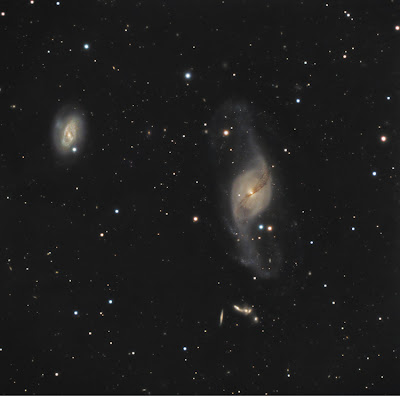
Originally discovered by Sir William Herschel during this very same month 211 years ago, NGC 3718 became the future study of an astronomer named Halton Arp. For 28 years Dr. Arp was staff astronomer at the Mt. Palomar and Mt. Wilson observatories and while there, he produced his well known catalog of Peculiar Galaxies that are disturbed or irregular in appearance. Needless to say, NGC 3718 became Arp 214: ""Barred spiral, (with a) sharp nucleus, narrow absorption lanes through center".
But it's not quiet and it's alone in the field. Joining warped NGC 3718 around 150,000 light years away is NGC 3729 - another massive galaxy which may be causing its neighbor's peculiarities. While the warping of galactic discs is common, the process is not quite yet understood. It's highly possible that tidal forces exerted by neighboring galaxies could be at work and in the case of this pair, it seems to carry through.
NGC 3718 contains an active galactic nucleus (AGN) and is known as a Seyfert Galaxy type 1.9 - one which may contain a massive black hole and is known for violent stars. Through HI mapping, NGC 3718 displays a tidal "tail" which begins on its eastern frontier and extends north towards its companion, NGC 3729. Is this just a case gravitational relationship? One galaxy consuming another? Let's find out…
It is commonly accepted that when galaxies pass each other that tidal forces draw out the companion galaxy's stars, gas, and dust in the formation of a spectacular tail. Just as it is commonly accepted that a merger of two spiral galaxies results in a remnant with an elliptical-like surface-brightness profile. In the case of NGC 3718, it would appear (according to interferometer data), the disk warp is evolving into a polar ring. No doubt, its molecular gas content is consistent with elliptical galaxy structure, but the distribution is warping the inner disk. At the same time, 2MASS data shows Arp 214's main support against gravitational collapse comes from pressure due to random motion of stars as seen in an elliptical galaxy rather than from rotation. The origin of the unusual combination of properties makes the whole scene not only beautiful to look at, but most unique.
But don't stop there… A closer examination of this picture will also show another another compact set of interacting galaxies as well - Hickson 56. Instead of two, there are five which share similarities with the closer cousins. Located some 400 million light years distant, this Hickson compact group has several catalogue designations including UGC 6527, VV 150, Markarian 176 and Arp 322 and were originally observed by Lord Rosse. According to Halton Arp, "Much print has been dedicated to explaining discordant redshifts in compact groups as unrelated background galaxies. But no one has analyzed the accordant galaxies. It is shown here that when there is a brightest galaxy in the group, the remainder with differences of less than 1000 km s−1 are systematically redshifted. This is the same result as obtained in all other well-defined groups and demonstrates again an increasing intrinsic redshift with fainter luminosity."
So what's Paul Hickson take? "Group 56 consists of five galaxies, three of which appear to be in contract and interacting. Two of these three galaxies (B and D) are stream of "galaxy stuff" linking its B and C components. An examination of the C galaxy reveals an asymmetric halo but D has a less complex outer luminosity profile. Last, but not least, both the A and D galaxies are Seyfert. More galaxies that have - or are - interacting in the past, present and future.
What's the chances of seeing some these galaxies yourself? Not bad at all. For the average-to-large telescope, NGC 3718 (RA 11 32 56 Dec +53 01 55) is roughly magnitude 10 to 11 (depending on whose scale you're looking at) and is noted as a soft, even haze with a dark dustlane seen upon aversion. NGC 3729 (RA 11 34 Dec +53 08), despite its magnitude billing is low surface brightness and requires a large telescope and aversion to detect. As for Hickson 56 (RA 11 32 46 Dec +52 56 28), you're going to need major aperture and excellent skies to even see a hint of this quintuplet.
Thanks to the photographic magic of Dietmar Hagar of Austria, we're able to enjoy this cosmic portrait. Using a 9" TMB refractor, the image was captured with a SXV H16 CCD camera and processed with AstroArt Software, Maxim DL and Registax. When Dietmar isn't busy being a trauma surgeon, he certainly takes outstanding astrophotos and is a member of the MRO imaging team. We thank him for sharing!
Written by Tammy Plotner